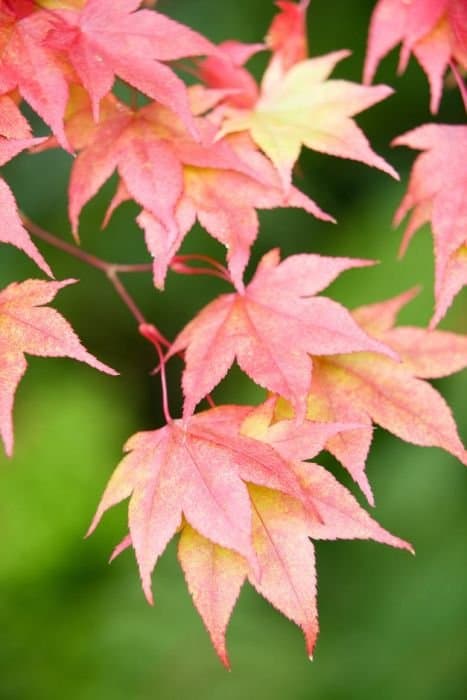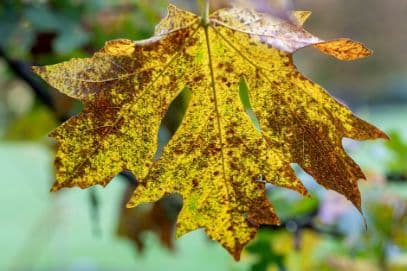Japanese Maple Acer palmatum 'Yasemin' (M)

ABOUT
Acer palmatum 'Yasemin', commonly known as Japanese maple, presents a remarkable display of foliage and an elegant branch structure. The leaves of this cultivar tend to have a distinct shape, characterized by multiple pointed lobes that resemble the palm of a hand, which is where the species gets its name. The foliage color can vary from a deep, rich green to burgundy, and in some cases, may present a variegated pattern combining green with creamy white or pink edges. During the spring season, the Japanese maple 'Yasemin' welcomes new growth that can appear with a bright and fresh hue, often standing in contrast to the darker tones of the mature leaves that develop later. These leaves then undergo a spectacular transformation in the fall, displaying a palette of vibrant colors ranging from fiery reds to glowing oranges and golden yellows, lighting up the garden with their autumnal show. The branches of the Japanese maple 'Yasemin' grow in a picturesque, often gracefully curved manner, creating a distinct, layered look that provides visual interest throughout the year, even in winter after the leaves have fallen. This branching pattern contributes to the plant's overall aesthetic, making it a favored choice for those looking to create a focal point in a landscape or simply enjoy the serene beauty of this ornamental tree. Japanese maples, including the 'Yasemin' variety, also produce small, attractive flowers in the springtime, though these are not as showy as the leaves and can be somewhat overlooked. Following the flowers, winged seeds called samaras mature and can be seen dangling from the branches, adding another element of interest. This plant is appreciated not just for its color and structure but also for its versatility in the landscape, as it can be an excellent plant to create a sense of structure or for use in Japanese-themed gardens. Its intricate leaf shape and seasonal color changes make the Japanese maple 'Yasemin' a much-admired specimen in the plant world.
About this plant
 Names
NamesFamily
Sapindaceae
Synonyms
Yasemin Japanese Maple
Common names
Acer palmatum 'Yasemin' (M)
 Toxicity
ToxicityTo humans
Japanese maple, which is the common name for Acer palmatum, is not generally considered toxic to humans. There are no well-documented cases of poisoning from ingesting this plant. Therefore, no specific symptoms of poisoning are associated with the Japanese maple.
To pets
Japanese maple is not typically considered toxic to pets. This means that ingestion of parts of the plant by pets, such as cats or dogs, is not expected to cause serious harm. While individual animals may have varying reactions to different plants, no specific or significant toxic effects are generally associated with this species.
 Characteristics
CharacteristicsLife cycle
Perennials
Foliage type
Deciduous
Color of leaves
Varies
Height
15-25 feet [4.6-7.6 meters]
Spread
10-20 feet [3-6 meters]
Plant type
Tree
Hardiness zones
5-9
Native area
Japan
Benefits
 General Benefits
General Benefits- Ornamental appeal: Acer palmatum, commonly known as Japanese Maple, features a delicate leaf shape and vibrant fall colors, enhancing garden aesthetics.
- Seasonal interest: Offers a year-round visual interest with changing leaf colors and textures throughout the seasons.
- Shade provision: Can create a cool, shaded area in the garden, which can be pleasant for seating or protecting understory plants.
- Wildlife support: Provides habitat and food sources for birds and beneficial insects.
- Compact size: Being a smaller tree, it's suitable for residential gardens or areas with limited space.
- Low maintenance: Once established, requires minimal care beyond occasional pruning to maintain shape and health.
- Variety: 'Yasemin' offers a unique variation in leaf color and form, giving gardeners the opportunity to diversify their plant collections.
- Erosion control: The root system can help stabilize soil and prevent erosion in the landscape.
 Medical Properties
Medical PropertiesThis plant is not used for medical purposes.
 Air-purifying Qualities
Air-purifying QualitiesThis plant is not specifically known for air purifying qualities.
 Other Uses
Other Uses- Photography enhancement - Japanese maple's distinctive leaves and form can be used as a stunning backdrop or focus in plant photography, particularly in autumn.
- Craft Material - The leaves of Japanese maple can be used in crafts such as leaf pressing resulting in beautiful and decorative art pieces.
- Bonsai Art - The Japanese maple is a popular choice for creating bonsai due to its beautiful color and leaf structure, offering an artistic hobby to enthusiasts.
- Ink and Dye Production - The leaves of Japanese maple can sometimes be used to produce natural dyes or inks for fabrics and artwork.
- Theme Gardening - They can be central to Japanese-themed gardens, allowing for a cultural expression through landscaping.
- Culinary Presentation - Leaves can sometimes be used as a natural garnish or decoration in high-end culinary dishes, although they are not edible.
- Educational Use - Japanese maple can serve as an educational specimen in botany and horticulture studies due to its unique characteristics and growing requirements.
- Feng Shui Application - The plant is sometimes used in Feng Shui to balance energies and contribute to a peaceful ambiance in gardens and homes.
- Literary Inspiration - Japanese maple has often inspired poets and writers, being featured in literature and poetry tied to nature and the changing seasons.
- Film and Theater Scenery - Branches or leaves can be used in set designs for films and theaters to create an authentic or dramatic Asian-inspired environment.
Interesting Facts
 Feng Shui
Feng ShuiThe Japanese Maple is not used in Feng Shui practice.
 Zodiac Sign Compitability
Zodiac Sign CompitabilityThe Japanese Maple is not used in astrology practice.
 Plant Symbolism
Plant Symbolism- Beauty: Acer palmatum, commonly known as Japanese Maple, is often associated with beauty due to its delicate and intricate foliage patterns.
- Peace: The calming aesthetic of the Japanese Maple's shapes and movements can symbolize tranquility and peace.
- Endurance and Change: With its ability to adapt and thrive in various climates, the Japanese Maple represents endurance and the ability to embrace change.
- Balance: The tree's balanced and symmetrical growth habit can symbolize harmony and equilibrium in life.
- Grace: The elegant form of Japanese Maple, especially the weeping varieties, convey a sense of grace and serenity.
 Water
WaterJapanese Maple should be watered regularly to maintain a consistently moist soil environment, especially during the first growing season to establish a deep, extensive root system. Provide roughly 2 inches of water per week, but be sure to adjust based on weather conditions. During hot, dry periods, waterings may need to be more frequent. Slow, deep watering is more effective than frequent shallow waterings, promoting healthier root growth. It's best to avoid overhead watering to minimize the risk of leaf scorch and other diseases.
 Light
LightJapanese Maple thrives in partial shade, particularly in the afternoon, to protect it from the harsh midday sun which can damage the delicate leaves. The ideal spot is one that receives morning sunlight and afternoon shade, or dappled sunlight throughout the day. This plant prefers a location that offers protection from strong winds.
 Temperature
TemperatureJapanese Maple prefers a temperate climate with temperatures ranging between 15 and 75 degrees Fahrenheit. It can survive minimum winter temperatures down to around -10 to 20 degrees Fahrenheit if properly mulched. Extreme heat and cold should be avoided, as it may stress the plant.
 Pruning
PruningPruning Japanese Maples is necessary to maintain their desired shape and to remove any dead or damaged branches. The best time to prune is in the late winter or early spring before new growth starts. Light pruning can be done throughout the growing season to shape or maintain size.
 Cleaning
CleaningAs needed
 Soil
SoilJapanese Maple 'Yasemin' thrives in a well-draining soil mix comprising one-third peat moss, one-third pine bark fines, and one-third coarse sand or pumice. The ideal soil pH for this Japanese Maple should be slightly acidic to neutral, generally around 5.5 to 7.0.
 Repotting
RepottingJapanese Maple 'Yasemin' should be repotted every 2-3 years. Younger trees may require more frequent repotting, while older, well-established specimens can be repotted less often.
 Humidity & Misting
Humidity & MistingJapanese Maple 'Yasemin' is adaptable but prefers moderate humidity levels, typical of its native woodland habitats. Avoid extremely low humidity to maintain plant health.
 Suitable locations
Suitable locationsIndoor
Position in bright, indirect light and away from dry heat.
Outdoor
Plant in dappled light with protection from harsh winds.
Hardiness zone
5-9 USDA
 Life cycle
Life cycleJapanese maple 'Yasemin' (Acer palmatum 'Yasemin' (M)) starts its life cycle as a seed, which after stratification (cold treatment), germinates in spring when temperatures warm up. The seedling then develops into a young sapling, experiencing rapid growth with the emergence of its characteristic palmate leaves. As it matures, it undergoes vegetative growth annually, usually with a flush of growth in the spring, followed by a more stable period through the summer and fall. The Japanese maple 'Yasemin' reaches maturity in several years, when it starts to produce seeds after the flowering stage, which is subtle with small purple or red flowers. Throughout its life, it undergoes seasonal changes, with foliage turning vibrant shades of red, orange, or yellow in the fall before leaf drop in winter. A mature Japanese maple 'Yasemin' can continue its growth and reproductive cycle for many decades, with proper care, before eventually reaching the end of its lifespan.
 Propogation
PropogationPropogation time
Late summer
Propogation: Acer palmatum 'Yasemin', commonly known as Yasemin Japanese Maple, is typically propagated by grafting, which is one of its most popular methods. This process is usually carried out in late winter or early spring before the sap begins to rise. In grafting, a piece of a stem with leaf buds, known as a scion, is inserted into the stock of another tree. The scion should be from a healthy, disease-free branch that has grown in the previous year. Both the stock and the scion are cut at a matching angle to ensure a good connection, and then they are bound together with grafting tape. The graft is often sealed with a grafting wax or similar substance to protect from diseases and prevent the wood from drying out. In time, the tissues of the two parts grow together and the scion develops into a new branch, eventually producing a clone of the original 'Yasemin' cultivar.








![Shirasawa maple [Moonrise]](/_next/image?url=https%3A%2F%2Fplants-admin.emdemapps.com%2Fimages%2Fplants%2F%2Fimages%2F604b5dde58337.png&w=640&q=75)
